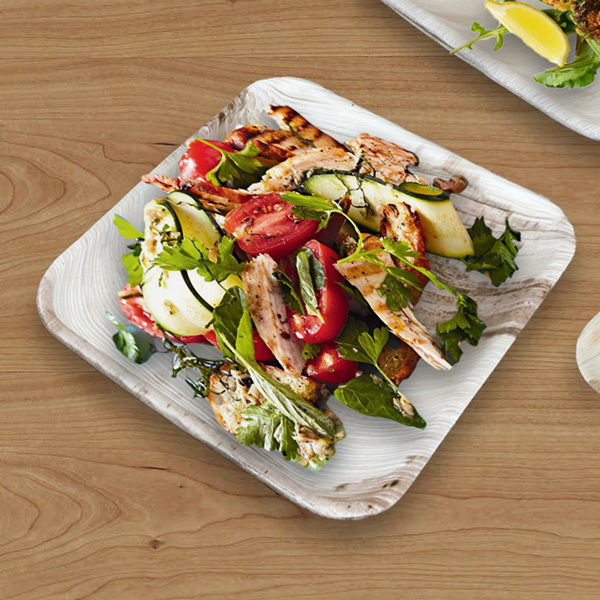Introduction to EcoLeaf Ensemble
In an era where sustainability is not just a choice but a necessity, EcoLeaf Ensemble emerges as a beacon of green innovation. This collection of eco-friendly tableware, made entirely from leaves, represents a significant step towards reducing our environmental footprint, one meal at a time.
Table of Contents
Why Eco-Friendly Tableware?
1. Reduction of Plastic Waste
The most obvious advantage of eco-friendly tableware is its ability to significantly reduce the amount of plastic waste. Traditional disposable tableware, such as plastic plates, cups, and cutlery, contributes to a massive portion of the waste in landfills and oceans. These plastics take hundreds of years to decompose, releasing harmful chemicals into the environment and posing a threat to wildlife. Eco-friendly alternatives, made from materials like bamboo, palm leaves, or compostable polymers, decompose much faster and more safely.
2. Lower Carbon Footprint
The production and disposal of plastic tableware consume a lot of energy and emit high levels of greenhouse gases, contributing to climate change. In contrast, eco-friendly tableware is often made from renewable resources and requires less energy to produce. Its compostable nature also means that, when disposed of properly, it returns to the earth without releasing toxic gases.
3. Conservation of Resources
Eco-friendly tableware is typically made from natural, renewable resources such as bamboo, sugarcane bagasse, or recycled materials. This not only reduces dependency on fossil fuels, which are used to make plastics, but also encourages the sustainable use of resources. By choosing eco-friendly options, consumers support industries that prioritize the health of the planet.
4. Promotion of Biodiversity
By opting for products made from rapidly renewable resources, consumers indirectly support practices that maintain biodiversity. Many eco-friendly products are sourced from materials that can be harvested without harming the natural habitat, unlike the extraction and processing of petroleum-based products, which can be destructive.
5. Health Benefits
Traditional plastic tableware often contains chemicals like BPA, phthalates, and other toxins that can leach into food and drinks, especially when heated. These substances have been linked to various health problems, including hormonal imbalances and increased cancer risk. Eco-friendly tableware, on the other hand, is generally made from natural materials that are safer for direct contact with food.
6. Enhanced Aesthetics
Beyond practical and environmental benefits, eco-friendly tableware often features unique, elegant designs that can enhance the dining experience. Items made from natural materials like wood, bamboo, or leaf can add a rustic, organic touch to meals, making them especially popular for events and establishments aiming for a natural, minimalist, or eco-conscious aesthetic.
7. Economic Benefits
While the initial cost of eco-friendly tableware may be higher than traditional plastic options, the long-term economic benefits, including reduced waste management costs and the potential for composting and resource recovery, can be significant. Additionally, as demand for sustainable products grows, prices are likely to become more competitive.
8. Social Responsibility
Choosing eco-friendly tableware reflects a commitment to social responsibility. It sends a message that consumers and businesses are willing to take concrete steps to protect the environment, even in their choice of tableware. This can inspire others to make more sustainable choices in their lives, creating a ripple effect that can lead to larger environmental benefits.
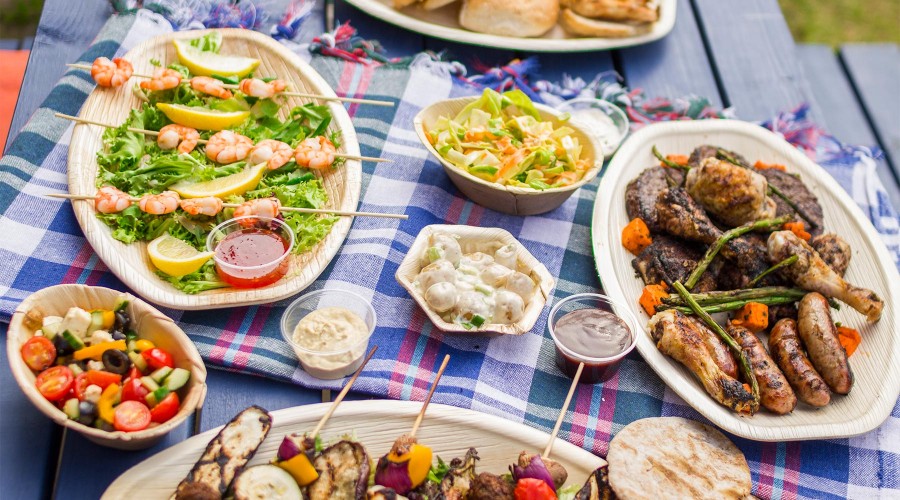
The EcoLeaf Ensemble
Materials and Sustainability
The core material of the EcoLeaf Ensemble is fallen leaves, primarily from areca palm trees. These leaves, which would otherwise decompose and return to the earth, are instead collected, cleaned, and transformed into durable tableware. This process is remarkably sustainable for several reasons:
- Renewable Resource: The leaves used are naturally shed by the trees, meaning no harm comes to the trees themselves, and the resource is naturally renewable.
- Chemical-Free Production: The manufacturing process is simple and involves no chemicals. The leaves are washed, heat-pressed into various shapes, and sterilized to ensure they are safe for use.
- Compostable End-of-Life: After use, EcoLeaf tableware can be composted, breaking down within a few months in a composting facility or a home compost, leaving no toxic residue behind.
Products in the Ensemble
The EcoLeaf Ensemble boasts an extensive range of products designed to cater to all dining needs, including:
- Plates and Bowls: Available in various sizes and shapes, suitable for main courses, salads, soups, and desserts.
- Serving Platters: Larger items for communal dishes, adding an elegant touch to any table setting.
- Cutlery: Forks, spoons, and knives made from the same sustainable materials, designed to complement the plates and bowls aesthetically and functionally.
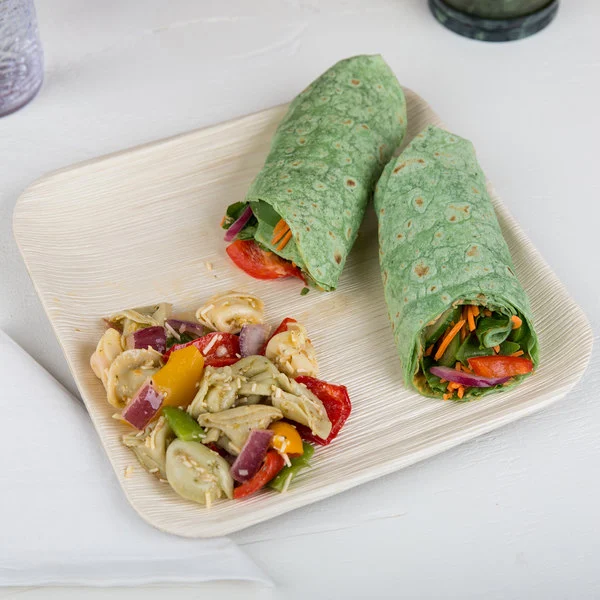
Environmental Benefits
The environmental benefits of adopting the EcoLeaf Ensemble are significant:
- Waste Reduction: By using compostable tableware, the amount of waste sent to landfills is dramatically reduced.
- Carbon Footprint: The carbon footprint associated with the production, use, and disposal of EcoLeaf tableware is minimal compared to plastic alternatives.
- Conservation: Using fallen leaves that would otherwise decompose, the EcoLeaf Ensemble promotes conservation of resources by repurposing natural materials without the need for deforestation.
Aesthetic and Practical Benefits
Aside from its environmental credentials, the EcoLeaf Ensemble offers practical and aesthetic advantages:
- Unique Presentation: The natural patterns and textures of the leaves make each piece of tableware unique, adding a rustic and organic charm to the dining experience.
- Durability and Functionality: Despite their natural origins, EcoLeaf products are surprisingly durable and capable of handling hot, cold, liquid, and solid foods effectively.
- Versatility: Suitable for a wide range of settings, from casual home meals to formal events, EcoLeaf tableware can elevate any dining occasion with its distinct style and sustainable ethos.
Benefits of Using EcoLeaf Tableware
1. Environmental Conservation
EcoLeaf tableware is made from naturally fallen leaves, which means their production doesn’t involve deforestation or harm to natural habitats. This sustainable sourcing conserves resources and supports the health of the planet. By choosing EcoLeaf, consumers contribute to reducing the demand for single-use plastics and non-renewable resources, thereby aiding in the conservation of ecosystems.
2. Biodegradability and Compostability
One of the most significant advantages of EcoLeaf tableware is its complete biodegradability and compostability. Unlike traditional plastic tableware that can take hundreds of years to decompose, EcoLeaf products break down within a few months in a composting environment. This feature significantly reduces the waste ending up in landfills and oceans, helping to tackle the global waste crisis.
3. Reduction in Carbon Footprint
The production process of EcoLeaf tableware is energy-efficient, emitting lower carbon emissions compared to the manufacture of plastic or paper tableware. Since the materials are sourced locally from fallen leaves, the carbon footprint associated with transportation is also minimized. By opting for EcoLeaf, individuals and businesses can lower their carbon footprint, contributing to global efforts against climate change.
4. Health and Safety
EcoLeaf tableware is free from synthetic chemicals and plastics that can leach into food, such as BPA, phthalates, and other potentially harmful substances found in conventional disposable tableware. This makes EcoLeaf a safer choice for serving food, especially hot and acidic dishes that can increase the risk of eaching from plastic containers.
5. Aesthetic Appeal
Beyond its environmental and health benefits, EcoLeaf tableware offers a unique and natural aesthetic that can enhance the dining experience. Each piece has its own texture and pattern, reflecting the beauty of nature. This can add a special touch to meals, making EcoLeaf particularly popular for events, weddings, and eco-conscious establishments looking to offer a distinctive and sustainable dining experience.
6. Versatility and Durability
Despite being made from natural materials, EcoLeaf tableware is surprisingly durable and versatile. It is suitable for a wide range of foods, including hot, cold, liquid, and solid dishes. The tableware is designed to be sturdy and functional, capable of handling various culinary needs without compromising on convenience or style.
7. Supporting Sustainable Practices
By choosing EcoLeaf, consumers and businesses support sustainable practices and industries. It encourages the market to shift towards more eco-friendly products and practices, driving innovation in sustainable materials and production methods. This, in turn, can lead to broader changes in consumer habits and industry standards, promoting a healthier planet.
8. Economic Efficiency
Although the initial cost of EcoLeaf tableware may be higher than conventional disposable options, its environmental benefits lead to long-term savings by reducing cleanup costs and waste disposal fees. Furthermore, businesses using EcoLeaf can attract environmentally conscious customers, potentially increasing their market appeal and customer base.
How EcoLeaf Compares to Other Eco-Friendly Tableware
Materials and Production
- EcoLeaf: Made from naturally fallen leaves, primarily areca leaves, which are cleaned, heat-pressed, and sterilized without the use of chemicals. This process is remarkably sustainable, utilizing a waste product from nature without harming any trees.
- Bamboo: Another popular eco-friendly material, bamboo is fast-growing and requires no fertilizer, making it a sustainable choice. However, turning bamboo into tableware often involves more intensive processing and the use of binders or chemicals to shape and finish the products.
- Sugarcane Bagasse: A byproduct of sugarcane processing, bagasse is biodegradable and compostable. While it’s an excellent use of waste material, the end products can sometimes be less sturdy and less water-resistant compared to EcoLeaf tableware.
- Cornstarch-based Bioplastics: These are made from renewable resources like corn starch. While they reduce reliance on fossil fuels, their biodegradability can vary, and they often require industrial composting facilities to break down properly.
Sustainability
- EcoLeaf: Offers a high degree of sustainability due to its use of waste materials and a chemical-free production process. It is fully compostable in a home composting system.
- Bamboo and Sugarcane Bagasse: Both materials are sustainable, but their production can be more resource-intensive than EcoLeaf. They are usually compostable, though commercial facilities may be required for optimal breakdown.
- Cornstarch-based Bioplastics: While they are a more sustainable option than traditional plastics, the agriculture practices used to grow the corn can impact their overall environmental footprint. They also often require industrial composting.
Functionality and Durability
- EcoLeaf: Known for its durability and heat resistance, EcoLeaf tableware can handle both hot and cold foods effectively, making it versatile for various dining needs.
- Bamboo: Extremely durable and can be reused many times, but it may not be as disposable or compostable as EcoLeaf, leading to different types of environmental impacts.
- Sugarcane Bagasse: Suitable for a wide range of uses, though sometimes less durable with very hot or liquid-heavy foods.
- Cornstarch-based Bioplastics: Good for a range of temperatures and uses, but their durability and functionality can vary widely depending on the specific product and manufacturer.
Aesthetic Appeal
- EcoLeaf: Each piece has a unique texture and pattern, offering an organic and rustic aesthetic that can enhance the dining experience, especially in settings where a connection to nature is desired.
- Bamboo: Offers a clean, minimalist look that’s popular in contemporary settings. Its natural grain adds to its appeal.
- Sugarcane Bagasse: Generally white or off-white, with a more utilitarian look that focuses on functionality over style.
- Cornstarch-based Bioplastics: Can mimic the appearance of traditional plastics, offering a familiar look but with a more environmentally friendly profile.

The Production Process
1. Collection of Leaves
The first step involves collecting fallen leaves, primarily from areca palm trees. These leaves are gathered without harming any trees, making the process highly sustainable. The collection is done manually, ensuring that only the best quality leaves are selected for production.
2. Cleaning
Once collected, the leaves undergo a thorough cleaning process. They are washed to remove any dirt and debris, preparing them for safe use in tableware production. This step is crucial for ensuring the final product is hygienic and suitable for holding food.
3. Sterilization
After cleaning, the leaves are sterilized to eliminate any bacteria or pathogens. This is typically achieved through a natural process using steam or heat, without the need for harmful chemicals. Sterilization ensures that the tableware is completely safe for direct contact with food.
4. Pressing
The clean and sterilized leaves are then pressed into various shapes using heat and pressure. Special molds are used to form plates, bowls, and other tableware items. This process does not require any additives or binding agents, as the natural fibers of the leaves fuse together under the heat and pressure to create a sturdy product.
5. Trimming and Finishing
After pressing, the edges of the tableware are trimmed to ensure a smooth, uniform appearance. This step also involves any final shaping or adjustments to achieve the desired product design. The finished products are then inspected for quality, ensuring they meet specific standards for durability, appearance, and functionality.
6. Packaging
Finally, the EcoLeaf tableware is carefully packaged using eco-friendly materials, ready to be shipped to consumers and businesses worldwide. The packaging is designed to protect the tableware during transport while minimizing environmental impact.
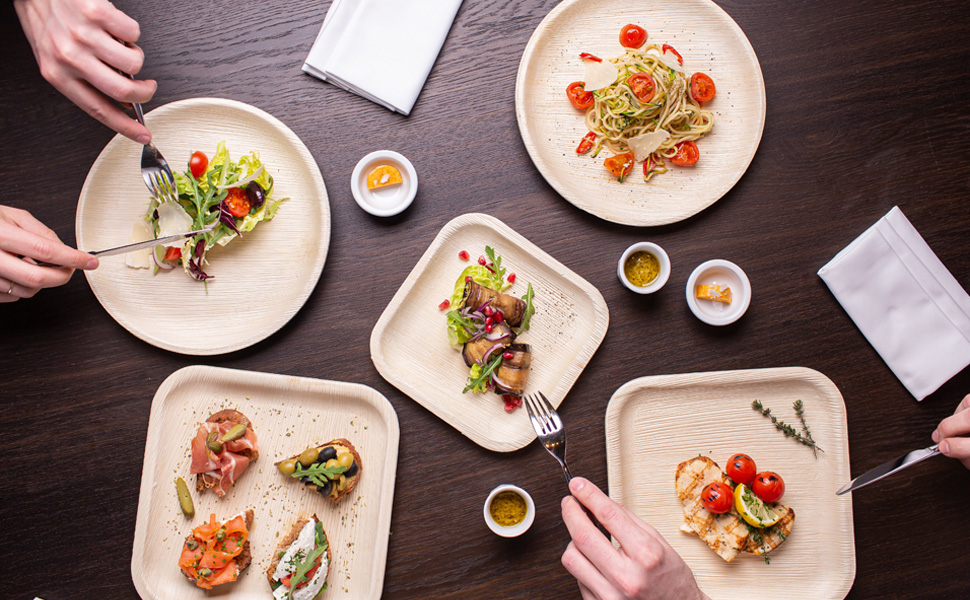
Key Features of the Production Process
- Eco-Friendly Materials: The use of natural, fallen leaves as the raw material ensures that the production process is sustainable and does not deplete natural resources.
- Minimal Environmental Impact: The entire production process is designed to have a low environmental footprint, with minimal water usage, energy-efficient manufacturing, and no need for harmful chemicals.
- Biodegradability: EcoLeaf tableware is completely biodegradable and compostable, breaking down naturally without leaving any toxic residues. This contrasts sharply with conventional plastic tableware, which can take hundreds of years to decompose and can release harmful substances into the environment.
- Cultural and Social Impact: In some regions, the collection and processing of leaves for EcoLeaf tableware provide valuable employment opportunities, supporting local communities and promoting sustainable livelihoods.
How to Integrate EcoLeaf into Your Lifestyle
1. Daily Dining
Replace traditional plastic or paper tableware with EcoLeaf for your daily meals. Its natural and compostable qualities make it an excellent choice for both hot and cold foods, providing a guilt-free dining experience. This small change can significantly reduce the amount of non-biodegradable waste you produce.
2. Special Occasions and Parties
Use EcoLeaf tableware for birthdays, weddings, anniversaries, or any celebration. Its unique and elegant appearance adds a special touch to these occasions, making your events stand out. Plus, the convenience of not having to wash dishes and the environmental benefit of using compostable tableware will be appreciated by your guests.
3. Outdoor Activities
EcoLeaf is perfect for picnics, camping, and barbecues due to its lightweight and disposable nature. You can enjoy the great outdoors without worrying about harming the environment with plastic waste. After use, the tableware can be responsibly disposed of in a compost bin.
4. Home Composting
If you’re into composting, EcoLeaf tableware can be added to your compost pile after use. It breaks down naturally, turning into nutrient-rich soil that can be used to fertilize your garden. This cycle of use and reuse aligns perfectly with sustainable living principles.
5. Eco-Friendly Catering
For businesses in the catering industry, adopting EcoLeaf tableware is an excellent way to showcase your commitment to sustainability. It’s an attractive selling point for clients who are environmentally conscious and prefer to support green businesses. This can also set your services apart in the competitive catering market.
6. Educational Opportunities
Use EcoLeaf tableware as a conversation starter about sustainability and environmental responsibility. It can serve as a practical example in educational settings or social gatherings to discuss the importance of eco-friendly practices and how small changes can make a big difference.
7. Corporate Events
For corporate meetings, conferences, or company picnics, opt for EcoLeaf tableware. It reflects the company’s dedication to environmental sustainability and can enhance the company’s image as socially responsible.
8. Gift Giving
EcoLeaf tableware sets can be unique and thoughtful gifts for friends and family, especially those who appreciate eco-friendly products or are looking to live more sustainably. It’s a practical, yet meaningful way to spread awareness about environmental issues.
9. Supporting Eco-Friendly Businesses
Purchasing EcoLeaf tableware supports businesses that are committed to sustainable practices, encouraging more companies to consider the environmental impact of their products and operations.
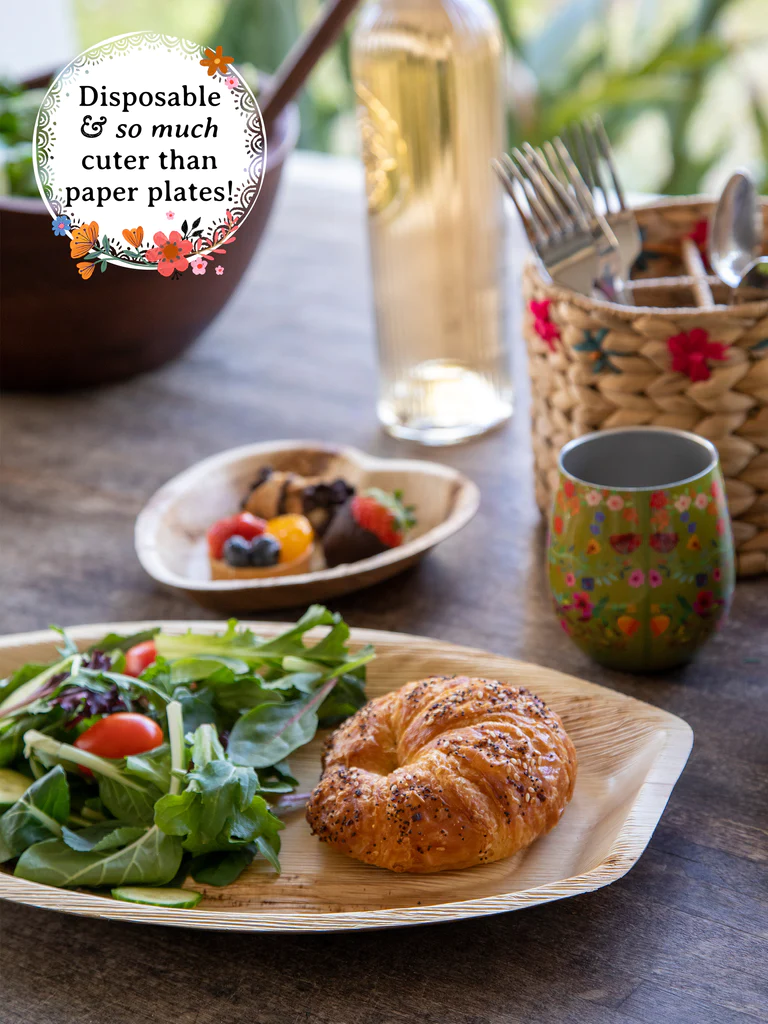
Caring for Your EcoLeaf Tableware
1. Gentle Use
- Avoid Sharp Objects: To prevent punctures or tears, avoid using sharp knives or utensils with the EcoLeaf tableware. Opt for softer or blunt-edged utensils to maintain the integrity of the plates or bowls during use.
2. Cleaning
- Light Cleaning: If you wish to reuse EcoLeaf tableware, gently wipe the surface with a damp cloth to remove any residue. These products are not designed to withstand heavy washing or scrubbing, as water can soften the material.
- No Dishwasher: EcoLeaf products should not be placed in the dishwasher. The high temperatures and water pressure can degrade the natural leaf material, rendering it unusable.
3. Drying
- Air Dry: After gently cleaning, allow the tableware to air dry completely before storing it. This helps to prevent mold or mildew from developing on any moist areas.
4. Storing
- Keep Dry: Store your EcoLeaf tableware in a dry, well-ventilated area to prevent any dampness, which could weaken the structure of the leaves.
- Stack Carefully: If stacking is necessary, do so gently to avoid crushing or bending the plates and bowls. Inserting paper towels between each piece can help absorb any residual moisture and prevent sticking.
5. Composting After Use
- Biodegradable: Once you’ve decided that your EcoLeaf tableware has reached the end of its useful life, you can compost it. Being made from natural materials, it will decompose in a compost pile, returning nutrients to the soil.
- Home Composting: Add your used EcoLeaf products to your home compost bin. Break them into smaller pieces to accelerate the composting process. Ensure your compost has a good mix of green and brown materials to facilitate decomposition.
6. Proper Disposal
- Compost Over Landfill: Although EcoLeaf tableware is biodegradable, it’s best to compost it rather than throwing it in the trash. Composting ensures that the tableware decomposes in an environment where it can contribute to creating nutrient-rich soil, rather than taking up space in a landfill.
7. Limit Reuse
- Assess Condition: Before reusing EcoLeaf tableware, assess its condition. If it shows signs of significant wear, such as deep stains, softening, or structural weakness, it’s better to compost it to avoid any risk of contamination or breakage during use.
Conclusion
Embracing EcoLeaf Ensemble is more than a choice; it’s a commitment to the planet. Its comprehensive range of leaf-made tableware offers a viable solution to the plastic problem, combining functionality with sustainability. As we move towards a greener future, EcoLeaf stands as a testament to what we can achieve when we choose to care for the earth.
FAQs
- Is EcoLeaf tableware really compostable? Yes, EcoLeaf tableware is fully compostable, breaking down naturally without leaving any harmful residue.
- Can EcoLeaf tableware be used for hot foods? Absolutely, EcoLeaf tableware is designed to withstand hot temperatures, making it suitable for a variety of dishes.
- How long does it take for EcoLeaf tableware to decompose? EcoLeaf tableware typically decomposes within a few months in a composting environment, much faster than plastic alternatives.
- Where can I purchase EcoLeaf Ensemble products? EcoLeaf Ensemble products are available through select retailers and online platforms. Check the official website for the most up-to-date list of stockists.
- How does using EcoLeaf tableware benefit the environment? Using EcoLeaf tableware reduces reliance on plastics, decreases waste in landfills, and minimizes the carbon footprint associated with the production and disposal of traditional tableware.
